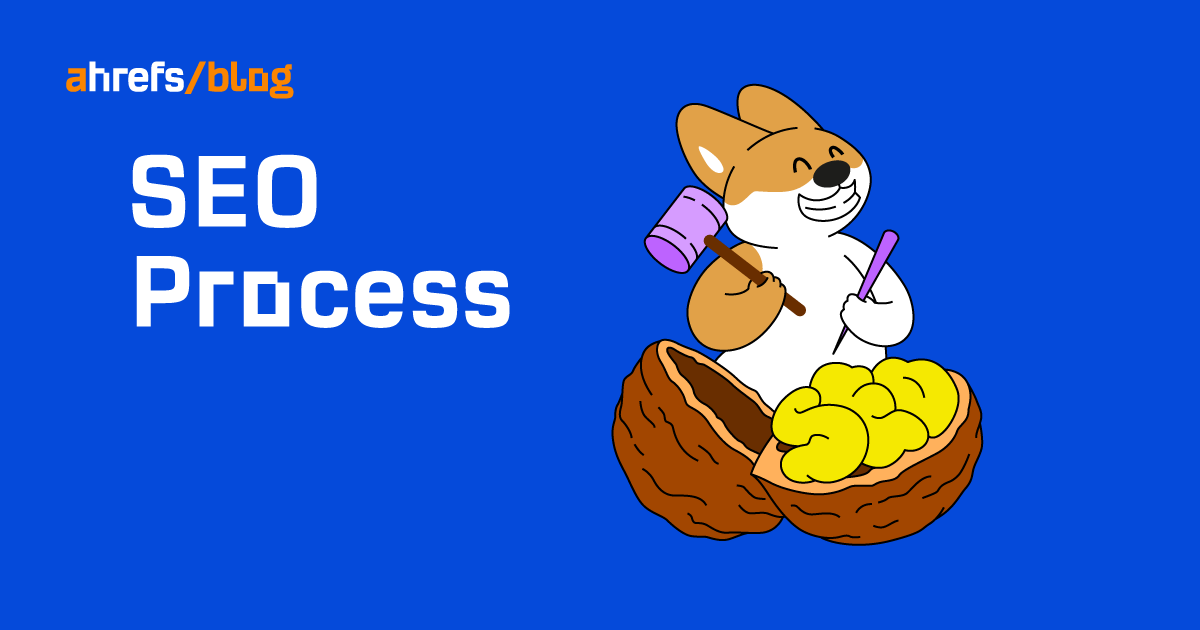SEO
The SEO Process in a Nutshell (4 Steps)

Search engine optimization (SEO) is the practice of growing a website’s traffic from organic search results. Everyone can do it, and it offers virtually free traffic. But similar to many things in life, success lies in understanding the correct process and sticking with it.
In this short article, I’ll try to distill the process of SEO into its essence: the four steps. To prove this process works, I’ll use our own example, i.e., the SEO process we’ve been using to grow a $100M+ annual recurring revenue SaaS company.
Here are the four steps of the SEO process:

Technical factors can impact your rankings or even prevent your site from appearing on Google’s search result pages.
To rank your content, Google needs to:
- Find and crawl your content – You won’t rank if your content is inaccessible to Google (this may be because of a disallowed Googlebot).
- Index your content – We’re talking about the master list of all pages that Google keeps in order to display them for relevant search queries. First off, you may choose not to appear in that index by leaving certain instructions for search bots. Also, Google may decide not to show certain pages if it thinks those pages are not the main version of the content (see canonicalization for more info).
In most cases, unless you’ve specifically instructed Googlebot not to crawl and/or index your site, your pages are ready to show up on the search engine results pages (SERPs). Keep in mind that it may take some time before Google indexes your content.
But that’s not the end of the technical SEO story. Multiple technical factors can negatively impact your rankings if they are broken but will work in your favor if they are set right.
The easiest solution to technical SEO issues is to get SEO auditing tools and fix any problems they report back to you. Two tools we recommend are Google Search Console and Ahrefs Webmaster Tools. You can also set up Bing Webmaster Tools if you want to monitor your performance on Bing.

To get traffic from search engines, you need to create content about something people search for. This is where keyword research tools, such as Ahrefs’ Keywords Explorer, come in.

With the help of keyword research tools, you’ll easily find hundreds or even thousands of keyword ideas.

But you also need to know how to choose the ones worth going after. So here’s what to consider when prioritizing keywords:
- Considerable search traffic potential – Search traffic potential (not to be confused with search volume) tells you how much traffic you can potentially get from a keyword.
- High business potential – Topics with high business potential can convert a good portion of your visitors to customers. Topics with low business potential will make it tough for you to feature your product/service. And topics with no business potential are usually only good for bringing more people through your door. But there are no guarantees people will actually be interested in what you offer.
- Low ranking difficulty – The more backlinks the top-ranking pages have and the more renowned the competing brands are, the harder it will be for you to rank.
- Clear search intent – The reason behind the search. Usually, it’s one of three things: finding a specific website, learning something, or buying something.

Keywords that tick all of the four things above are an ideal situation, but that doesn’t happen all of the time. Mostly, SEOs and content marketers need to go for compromises, e.g., targeting a keyword with high business potential but lower traffic potential.
The content of a page is something that allows Google to “connect you” with the searchers. The more interesting and useful your content is, the better. And that’s because quality content is something users expect and search engines need to provide. In fact, Google admits that content is the most important ranking signal.

Creating content designed to rank (so-called SEO content) is a nuanced topic. It has a process of its own, and there are lots of details to take care of.
To make things even harder, how Google ranks content is kept a secret. But Google actually provides a hint on the five things that determine which results will be shown for a given search query:
- Meaning – How well a page matches searchers’ expectations. The highest-ranking content on the SERPs is usually the best place to check that.
- Relevance – Does a page contain relevant information, e.g., words, phrases, and even pictures and videos relevant to what the searchers are looking for.
- Quality – Content also needs to be helpful. To determine content quality, Google will take into account both factors occurring on the page (e.g., E-A-T, clear and organized form, freshness) and those occurring outside the page (backlinks, which we’ll talk more about later).
- Usability – If your pages and your competitors’ are equal in every other way, Google may allocate a higher ranking to pages that it finds more accessible (e.g., mobile-friendly, secured with an SSL, fast loading).
- Context and settings – Google may customize search results based on users’ search history and their current whereabouts. This is why local business owners may want to prioritize keywords with local search intent.
Now, there are techniques SEOs and content marketers use to adhere to these guidelines. But there are too many to explain in this short article. If you want to take a moment to learn about those techniques, see the video below. Otherwise, let’s move on to the next point: building links.
https://www.youtube.com/watch?v=ZWiNz-7gZ24
Sidenote.
Not all SEO efforts are used for ranking higher in the search results. Some of them optimize elements that are not ranking factors but are visible to the user and can increase the chances of the site getting a click. Examples are the meta description, schema markup, etc.
Recommended reading: What Is SEO Content? How to Write Content That Ranks
You’ll need two types of links: internal links and backlinks. Both are ranking signals, with backlinks being one of the major signals in SEO.
Internal links
Internal links are links from other pages on the same website, e.g., a link from one article to another on our blog. Their main roles in SEO are to help search bots crawl pages more efficiently and pass link equity from linking pages.
Because of the above reasons, you probably won’t find an article on our blog without at least one internal link pointing to another article or a product landing page.
By having internal links, we can create a situation where a page with a lot of backlinks can give a much-needed boost to newer pages (see the middleman method for more details).


Backlinks
Backlinks are links from external websites. They act as votes. The more “votes” you get, the higher your chance of outranking the competition.
The difficulty here is that you can’t fully control backlinks. You can either earn them organically (wait for people to discover you and link to you) or build them (ask people to link to you). Let’s look at that in more detail.
In the picture below, you can see examples of our case studies that continue to earn backlinks organically.
The first article about the time needed to rank on Google provides a data-backed answer to a common question about SEO.
The second one offers an intriguing and unique insight into the effectiveness of SEO. In this article, we focus on the fact that if you write about SEO, it’s hard to ignore that most content doesn’t get any traffic from Google.

And here’s an example of a content piece, 63 SEO Statistics. The piece was created because we wanted to specifically run an outreach campaign about it. Unlike the previous examples, it doesn’t need any original studies. Our process was:
- Researching most cited SEO statistics among the top-ranking articles.
- Finding and including their more up-to-date versions in our article.
- Asking people who linked to websites with outdated statistics to link to our article instead (that’s the outreach part).

Regarding backlinks, it’s important to know that not all links will carry the same weight.
Generally speaking, the best links you can get are “followed” links placed within the main content and those that come from relevant, authoritative websites.
Head on to the guides listed below if you want to learn more about backlinks and link building.
Final thoughts
SEO is a long-term process that sometimes needs to be revisited. So it’s always a good idea to know exactly what you want to achieve before you invest your resources. For this, you can use this tried and tested method called the goal pyramid.
Lastly, it’s important to monitor results on a regular basis because search engine rankings tend to change. For this, it’s best to use a tool that tracks your ranking history and shows how you stack up against competitors (see our Rank Tracker, for example).
Got questions or comments? Ping me on Twitter.













You must be logged in to post a comment Login